How Family Bonds Hitting Financial Security Of Retirees
Placing immense value on children's education, many Indian parents unknowingly jeopardising their retirement security
How Family Bonds Hitting Financial Security Of Retirees

As the middle-class narrative in India has long revolved around investing in children's education, a new crisis looms- parents are increasingly sacrificing their own financial future for their children's academic success. With education costs soaring and retirement savings being neglected, this cultural norm is leading many to enter their retirement years unprepared
Last week, I mentioned the individuals' emotional preparedness (or lack thereof) for their retirement. My experience also brought insights into another behavioral aspect of the individuals: they somehow mention retirement as their highest priority while providing a relatively lower preference during capital allocation. This is understandable with younger investors, but it is perplexing to see a higher number of older individuals indulging in this.
Indians have been driven by family value systems through the ages, the joint-family system helped not just bind the members but also provide stability, support, and scale each member's needs. For decades, especially post-liberalisation aided by globalisation, the middle-class success story hinged on a deep-rooted belief that education is the ultimate investment for a prosperous future. And parents have poured their huge resources into ensuring their children's education through costlier schooling, higher college funding, etc.
This cultural priority (of supporting children) now clashes with another critical financial need, retirement planning. This has become stark with the nuclear family structure and volatile external environment (limited state support). The deprioritising of their financial security to fund children's education, often at a steep cost is a grave evolving scenario. A World Bank study (2020) describes Indian parents' tendency towards "familial altruism", sacrificing their own needs for their children's future.
The leveraged finances to fund higher education are adding anxiousness to both the students and parents as the career prospects post-education have remained uneven. What has brought further woes is the lack of planning at the beginning or doing away with this need, often resulting in compromising retirement planning.
A PGIM India MF survey (2023) found that 60 per cent of Indian investors prioritise education funding over retirement, even among the older age groups. While 52 per cent of parents start saving for their children's education before even considering retirement according to Bankbazaar's moneymood survey (2022). And 74 per cent of the parents are willing to take on debt for their child's higher education (one of the highest globally) per HSBC's The Value of Education report (2017).
Unfortunately, this trend persists despite the glaring timeline crunch: the years when children need funds for higher education (typically early 20s) often overlap with when parents should be aggressively saving for retirement (early/mid-50s). And for those with multiple children, the financial strain is even worse. The situation has turned a double whammy with the skyrocketing of education costs, well over the general inflation or income growth.
The education costs in India rise by 10-12 per cent annually per the Crisil (2022) report. The RBI (2022) data shows that 25 per cent year-on-year surge in education loans, with many parents resorting to financial loans or dipping into retirement savings.IDFC First Bank's (2023) survey found that Indian parents spend Rs. 35-40L on average per child for undergrad studies abroad with the US, UK, Canada, and Australia as top destinations.
While the ticket to admission doesn't end the financial stress as uncertain job markets mean hefty investments, children mayn't secure high-paying jobs immediately, leaving parents anxious about their loan repayments and their retirement preparedness. SEBI's investor survey (2023) revealed that 65 per cent of Indians start retirement planning only after 40, by which time education expenses are peaking.
Society must comprehend that it's neither the parents' obligation nor the children's birthright to fund higher education predominantly sidelining retirement needs. The major fallout of this cultural obligation is that many Indians are reaching retirement age without adequate savings. Deloitte's Retirement Readiness survey (2023) noted that only 28 per cent of urban Indians feel financially secure for retirement with middle-class parents worst affected. Per SBI's retirement report (2022) 35 per cent of retirees rely on their children for support – very ironic, given that many exhausted their savings on those children's education.
This is a wakeup call for the sunset generation which was earlier the sandwiched one to recognise the futility of indulging in this emotional and cultural recklessness. While funding for children's higher education is a noble cause, it's a risky trade-off to sacrifice retirement stability. The key lies in planning early, saving smartly, and balancing both priorities with better allocation and cost estimation, ensuring that education needs are not at the price of retirement.
(The author is a partner at Wealocity Analytics, a SEBI registered Research Analyst, and could be reached at [email protected])

